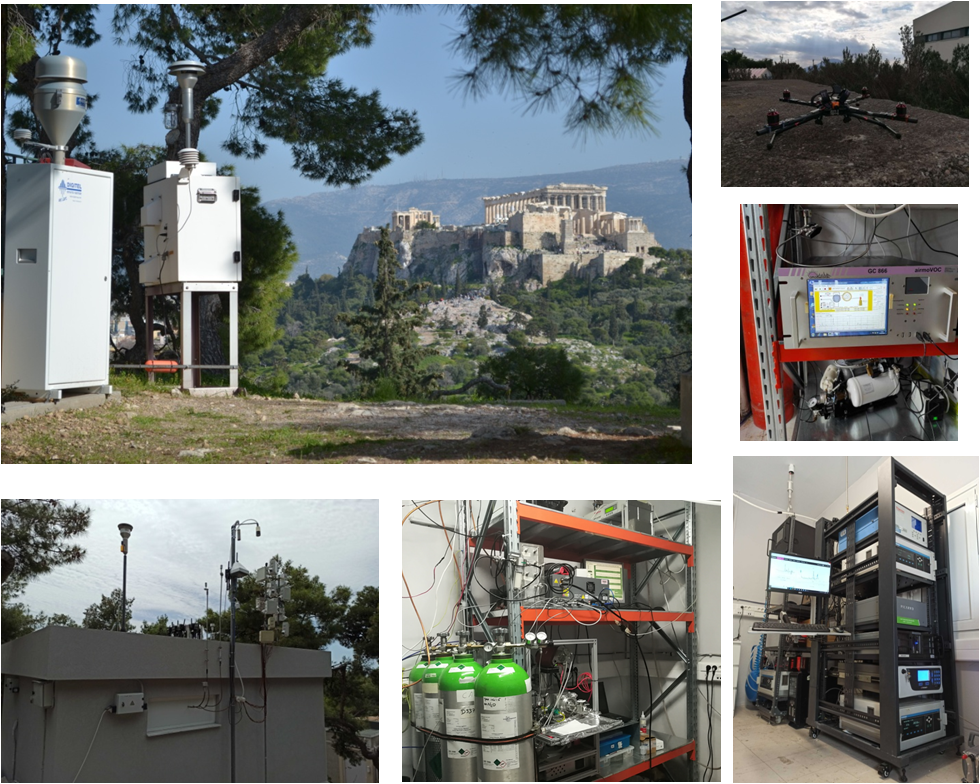Thissio Air Monitoring Station (Thissio AMS)
The Thissio Air Monitoring Station (Thissio AMS), operating since 2013, is located at the central premises of the National Observatory of Athens, in the historical center of the city (Thissio area, 37.97°N, 23.72° E, 105 m a.s.l.), overlooking the Attica basin from approximately 50m above the mean city level.
The location, on the top of the hill of Nymphs, is ideal for urban background air quality conditions characterization, since the station is located close to the city center and serves as a receptor point of aerosols from various urban and regional sources. It is surrounded by a pedestrian zone, at a moderately populated residential area and the Filopappou (108 m a.s.l) and Acropolis hills (150 m a.s.l), located 500m and 800m away, respectively. There are no major roads within a radius of 500 m.
AMS is part of the PANhellenic infrastructure for Atmospheric Composition and climatE chAnge (PANACEA) National Research Infrastructure (RI) and the Aerosols, Clouds and Trace gases ACTRIS pan-European RI. It also operated infrastructure for monitoring greenhouse gases levels within the frame of the Integrated Carbon Observation System (ICOS) pan-European RI. It is organized and operates according to the integrated strategic plan of the RIs, aiming at high quality and resolution measurements for the provision of near real time information on urban air quality to the citizens, the state and private entities.
The main operation of the station is to monitor atmospheric composition changes and the air quality of the urban environment. This includes, among others, the study of aerosol chemical composition and physical and optical properties, in order to investigate their sources within the urban environment of Athens, their production and transport processes over the Eastern Mediterranean, their climatic role and impacts on health, ecosystems and monument building materials.
Thissio AMS also operates as a hub for highly specialized atmospheric measurements, offering transnational access to interested scientists or students and hosting experimental campaigns, indicatively: (a) monitoring of wintertime smog events, since 2014; (b) wood burning targeted Airborne Unmanned Aerial Vehicle (UAV) observations in Athens, ACTRIS JRA1 campaign (winter 2015-2016); (c) monitoring of the health-related, aerosol oxidative potential, since 2016, (d) climate-relevant measurements (Cloud Condensation Nuclei, 2017-2018); (e) PANACEA seasonal campaigns (2019-2020); (f) evaluation of automated Total Carbon analyzer by Magee Scientific (2019-2021); evaluation and calibration of low/medium cost sensors by intercomparison with reference instruments (2019-2021).
The infrastructure of the station has been continuously upgraded and is currently equipped with specialized on line, high-resolution analyzers for: major gaseous (CO, NO, NO2, SO2, O3) and particulate pollutants (PM1, PM2.5, PM10, BC and its BCff-BCwb fractions), aerosol absorption, scattering and number size distribution, fine aerosol non-refractory chemical speciation (Cl-, NO3-, SO42-, NH4+, Org in PM1) and greenhouse gases (CH4, CO, CO2). At the end of 2021, an automatic gas chromatograph was also installed for the determination of non-methane hydrocarbons with 6 to 12 carbon atoms.
High and low volume samplers for different size fractions (PM2.5 and/or PM10) are utilized on a 24-hours basis (or 12-hours intervals during intensive campaigns) and filter samples are analyzed on a routine basis for the determination of the levels of anions (e.g. Cl-, NO3-, SO42-), cations (K+, Na+, Ca2+, Mg2+, NH4+), elemental and organic carbon (OC and EC) and oxidative potential of aerosols (OP) as well, whereas trace and heavy metals (e.g. Cu, Fe, Pb), brown carbon (BrC) and organic compounds (e.g. levoglucosan, galactosan, mannosan, Polycyclic Aromatic Hydrocarbons and Quinones (PAHs and PAQs)) are further investigated depending on research priorities and needs.
Campaign-based measurements of the ΡΜ1 ionic composition, gaseous acidic compounds such as H2SO4, HNO3 and HCl, as well as for non-methane hydrocarbons with 2-12 carbon atoms have been conducted in Thissio AMS. The infrastructure is further supported by unmanned aerial systems, carrying sensor-based monitors for targeted recording of atmospheric parameters (e.g. temperature, humidity), black carbon and particle size distributions aloft. The results of the measurements were integrated in scientific studies, producing a large number of announcements in conferences and publications in journals with peer review system over the last years.

The following instruments are in continuous operation in the Thissio AMS:
|
Pollutant/Property |
Equipment |
|
Carbon Monoxide (CO) |
Analyzer APMA-360, Horiba Ltd. |
|
Nitrogen Oxides (ΝΟx) |
Serinus 40, ACOEM Ecotech |
|
Nitrogen Oxides (ΝΟx) |
Analyzer APNA-360, Horiba Ltd** |
|
Sulphur Dioxide (SO2)* |
Analyzer APSA-360, Horiba Ltd. |
|
Ozone (Ο3) |
Analyzer 49-i, Thermo Scientific |
|
Greenhouse Gases (GHGs; CO2, CH4, H2O) |
Analyzer G2301, Picarro Inc |
|
Volatile Organic Compounds (BTEX, C6-C12) |
Auto GC-FID, GC 866 airmoVOC, AIRMOTEC A.G. (Chromatotec Group) |
|
Particulate Matter PM2.5 |
Beta gauge particulate monitor 5014i, Thermo Fisher Scientific Inc. |
|
Particulate Matter PM10** |
Beta gauge particulate monitor FH 62 I-R, Eberline |
|
Particulate Matter PM1, PM2.5,PM10 |
Μodel 11-D, Grimm Aerosol Technik |
|
Black Carbon (ΒC) – Aerosol Absorption |
Aethalometer 7-λ, Model ΑΕ33, Magee Scientific |
|
Black Carbon, ΒC* |
5012 Multi Angle Absorption Photometer MAAP, Thermo Scientific |
|
Aerosol Scattering |
Integrating Nephelometer model 3563, TSI |
|
Aerosol number size distribution |
Model 3034 Scanning Mobility Particle Sizer-SMPS, TSI |
|
Particle Number Concentration |
Model 3010 Condensation Particle Counter, TSI Inc. |
|
Chemical composition of non-refractory submicron aerosol (Organics, Cl-, NO3-, SO42- και NH4+) |
Aerosol Chemical Speciation Monitor-ACSM, Aerodyne Inc. |
|
ΡΜ1 ionic composition (cations)** |
Particle-Into-Liquid-Sampler - Ion Chromatograph, PILS - IC, Metrohm – Dionex |
|
Sequential low volume aerosol sampler (ΡΜ2.5, ΡΜ2.5-10)** |
Dichotomous Partisol – Plus, Model 2025 Sequential Air Sampler, ThermoScientific |
|
Sequential low volume aerosol sampler (ΡΜ2.5 or ΡΜ10) |
Sampler LVS 3.1 – PNS 15, Derenda |
|
High volume aerosol sampler (ΡΜ2.5) |
Digitel DH-77 |
|
Datalogger |
Congrego v.4.0.1, Ecotech |
|
* Equipment also used in the Mobile Air Quality Monitoring Station **Equipment used in past long-term measurements |
|

